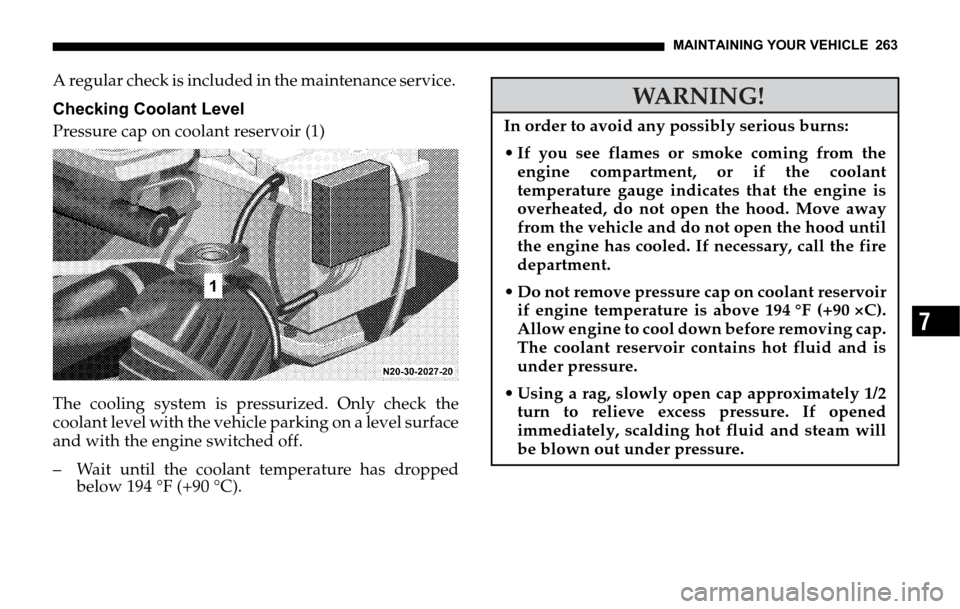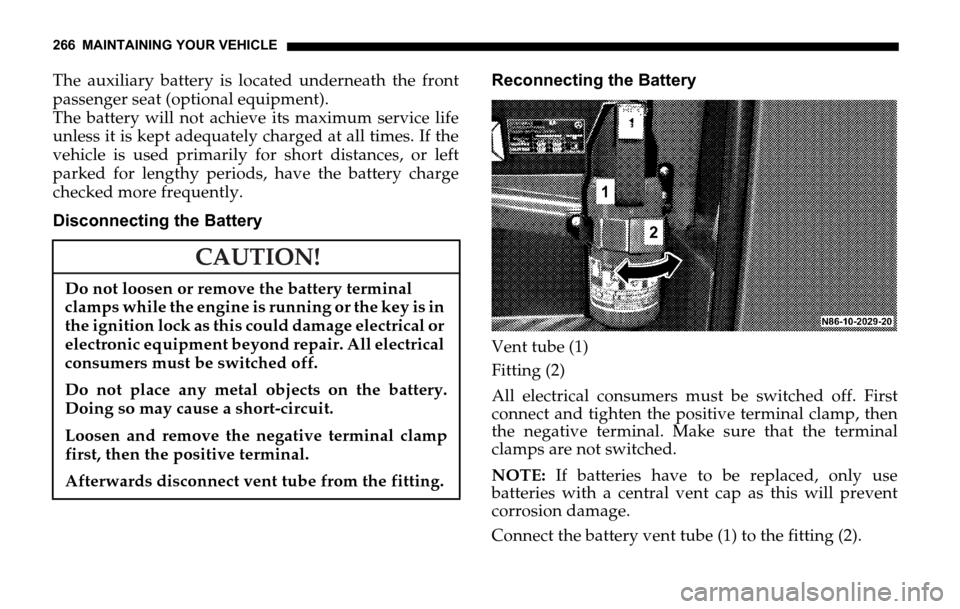check engine DODGE SPRINTER 2006 1.G Owner's Manual
[x] Cancel search | Manufacturer: DODGE, Model Year: 2006, Model line: SPRINTER, Model: DODGE SPRINTER 2006 1.GPages: 330, PDF Size: 10.82 MB
Page 263 of 330

MAINTAINING YOUR VEHICLE 263
7
A regular check is included in the maintenance service.
Checking Coolant Level
Pressure cap on coolant reservoir (1)
The cooling system is pressurized. Only check the
coolant level with the vehicle parking on a level surface
and with the engine switched off.
– Wait until the coolant temperature has dropped
below 194 °F (+90 °C).
WARNING!
In order to avoid any possibly serious burns:
If you see flames or smoke coming from the
engine compartment, or if the coolant
temperature gauge indicates that the engine is
overheated, do not open the hood. Move away
from the vehicle and do not open the hood until
the engine has cooled. If necessary, call the fire
department.
Do not remove pressure cap on coolant reservoir
if engine temperature is above 194 °F (+90 ×C).
Allow engine to cool down before removing cap.
The coolant reservoir contains hot fluid and is
under pressure.
Using a rag, slowly open cap approximately 1/2
turn to relieve excess pressure. If opened
immediately, scalding hot fluid and steam will
be blown out under pressure.
Page 264 of 330

264 MAINTAINING YOUR VEHICLE
Open the hood.
At first, only turn the pressure cap on coolant
reservoir to the first detent to release the pressure
from the cooling system. Only then should the
pressure cap be removed completely.
To add coolant:
If the engine is cold:
Add coolant until the coolant level reaches the base
area which is visible through the filler opening (area
moistened).If the engine is already at its regular operating
temperature:
Add coolant until the coolant level is about 0.6 inch
(1.5 cm) above the base area which is visible
through the filler opening.
Replace and tighten the pressure cap on coolant
reservoir.
If a large quantity of coolant has been lost, or if smaller
amounts are lost at regular intervals, have the engine
cooling system examined by an authorized Sprinter
Dealer.
For coolant composition and water quality, contact
your Sprinter Dealer.
WARNING!
Do not spill antifreeze on hot engine parts. Anti-
freeze contains ethylene glycol which may burn
if it comes into contact with hot engine parts.
Check coolant level only with the engine
switched off and the key in position 0 in the
ignition lock.
Page 265 of 330

MAINTAINING YOUR VEHICLE 265
7
WINTER OPERATION
Have your vehicle winterized by an authorized
Sprinter Dealer before the onset of winter.
Have the engine oil changed, if the engine oil filled
is not approved for winter use.
Coolant: antifreeze/anti-corrosion concentration in
the coolant checked.
Windshield washer system and headlamp cleaning
system (optional): add windshield washer fluid
"winter wash" to the water, depending on ambient
temperatures.
Battery: the battery will lose capacity as
temperatures drop. Only a well-charged battery will
ensure reliable engine starting even at low outside
temperatures.
Tires: fit M+S radial tires with a minimum tread
depth of approximately 1/6 in (4 mm) on all wheels
for the winter season.BATTERIES
The standard battery is located in the engine
compartment.
WARNING!
Failure to follow these instructions can result in
severe personal injuries and death.
Never lean over batteries while connecting, you
might get injured, if the battery explodes.
Battery fluid contains sulfuric acid. Do not allow
this fluid to come in contact with eyes, skin or
clothing. In case it does, immediately flush
affected area with water and seek medical help if
necessary.
A battery will also produce hydrogen gas, which
is flammable and explosive. Keep flames or
sparks away from battery, avoid improper
connection of jumper cables, smoking etc.
Use only impact-resistant batteries with a central
gas release cover to prevent corrosion damage and
to prevent occupants from caustic burns in the
event of an accident.
Page 266 of 330

266 MAINTAINING YOUR VEHICLE
The auxiliary battery is located underneath the front
passenger seat (optional equipment).
The battery will not achieve its maximum service life
unless it is kept adequately charged at all times. If the
vehicle is used primarily for short distances, or left
parked for lengthy periods, have the battery charge
checked more frequently.
Disconnecting the BatteryReconnecting the Battery
Vent tube (1)
Fitting (2)
All electrical consumers must be switched off. First
connect and tighten the positive terminal clamp, then
the negative terminal. Make sure that the terminal
clamps are not switched.
NOTE: If batteries have to be replaced, only use
batteries with a central vent cap as this will prevent
corrosion damage.
Connect the battery vent tube (1) to the fitting (2).
CAUTION!
Do not loosen or remove the battery terminal
clamps while the engine is running or the key is in
the ignition lock as this could damage electrical or
electronic equipment beyond repair. All electrical
consumers must be switched off.
Do not place any metal objects on the battery.
Doing so may cause a short-circuit.
Loosen and remove the negative terminal clamp
first, then the positive terminal.
Afterwards disconnect vent tube from the fitting.
Page 303 of 330

MAINTENANCE SCHEDULES
CONTENTS
8
M
A
I
N
T
E
N
A
N
C
E
S
C
H
E
D
U
L
E
S
�Q Introduction . . . . . . . . . . . . . . . . . . . . . . . . . . . . . . 304
�Q Warranty . . . . . . . . . . . . . . . . . . . . . . . . . . . . . . . . . 304
�Q Maintenance - Without ASSYST
Maintenance Computer . . . . . . . . . . . . . . . . . . . . . 305
�…Maintenance Intervals . . . . . . . . . . . . . . . . . . . . 305
�Q Maintenance - With ASSYST
Maintenance Computer . . . . . . . . . . . . . . . . . . . . . 306
�Q Regular Check-Ups. . . . . . . . . . . . . . . . . . . . . . . . . 306
�Q Special Maintenance Requirements . . . . . . . . . . . 307
�…Brake Fluid . . . . . . . . . . . . . . . . . . . . . . . . . . . . . 307
�…Coolant . . . . . . . . . . . . . . . . . . . . . . . . . . . . . . . . . 307
�…Dust Filter for Heating/Ventilation
Replacement . . . . . . . . . . . . . . . . . . . . . . . . . . . . 307
�Q Engine Oil Change and Filter Replacement . . . . 307
�…Once a Year . . . . . . . . . . . . . . . . . . . . . . . . . . . . . 307
�Q Scope of Work for Maintenance service . . . . . . . 308
�…Oil Service . . . . . . . . . . . . . . . . . . . . . . . . . . . . . . 308
�…Additional Maintenance Work . . . . . . . . . . . . . 310
�…Additional Maintenance Work After ... Years 310
Page 306 of 330

306 MAINTENANCE SCHEDULESM
A
I
N
T
E
N
A
N
C
E
S
C
H
E
D
U
L
E
S
8
MAINTENANCE - WITH ASSYST MAINTENANCE
COMPUTER
ASSYST provides you with information on the best
possible timing for maintenance work.
When the next maintenance service is due, this will be
indicated in the multi-function display with the
symbol
9 Oil service and fuel filter replacement
9 Maintenance service - displayed in km/miles
or days.
9
If the display shows the number of days, the symbol
È will also appear in the multi-function display.
You should have the maintenance performed within
the stated period/distance.
The service indicator will be reset by your Sprinter
Dealer after an oil service and/or maintenance service
has been performed.REGULAR CHECK-UPS
To maintain the safe operation of your vehicle, it is
recommended that you perform the following tasks on
a regular basis (i.e., weekly or whenever the vehicle is
refueled). Check:
Engine oil level
Brake system, clutch mechanism – fluid level
Battery – acid level
Windshield washer system and headlamp cleaning
system – fluid level
Mechanical assemblies (e. g. ,engine, transmission,
etc.) – check for leaks
Condition of tires and tire pressures
All exterior lights
Page 307 of 330

MAINTENANCE SCHEDULES 307
8
M
A
I
N
T
E
N
A
N
C
E
S
C
H
E
D
U
L
E
S
SPECIAL MAINTENANCE REQUIREMENTS
If bodies built by manufacturers other than
DaimlerChrysler Corporation are fitted to the vehicle, the
maintenance requirements and lubrication intervals
specified by the body manufacturer must be adhered to,
in addition to all standard maintenance requirements.
Brake Fluid
Only use brake fluids approved by the manufacturer
(DOT 4 plus). Information about brake fluids is
available from your Sprinter Dealer.
Coolant
Have the corrosion inhibitor/antifreeze concentration
in the coolant checked before the onset of winter (once
a year in countries with high prevailing temperatures).
Have the coolant renewed every fifteen years or
100,000 miles.
Dust Filter for Heating/Ventilation Replacement
The dust filter and the tailgate interior filter are
renewed during routine maintenance service.
However, if operating conditions are dusty, these
filters should be renewed more frequently.ENGINE OIL CHANGE AND FILTER
REPLACEMENT
In a minimum, change the engine oil and oil filter once
a year - even if the vehicle mileage per year is extremly
low. For standard oil service schedules, please see the
chapter oil service and maintenance service.
Once a Year
Select the viscosity of the engine oil (SAE classes)
according to the outside air temperature.
Only use engine oil approved by DaimlerChrysler
Corporation if following the ASSYST system
guidelines.
Information is available from your Sprinter Dealer.
If the fuel used has a sulphur content exceeding 0.05 %
by weight, the service intervals should be split in half.
If the sulphur content of the fuel used is between 0.3%
and 0.8% by weight, the service intervals should be
split in half (i.e. every 5,000 miles instead of every
10,000 miles).
Page 308 of 330

308 MAINTENANCE SCHEDULESM
A
I
N
T
E
N
A
N
C
E
S
C
H
E
D
U
L
E
S
8
SCOPE OF WORK FOR MAINTENANCE SERVICE
Oil Service
Oil change
Engine:
Oil change and filter replacement
Check fluid levels of the following system, refill as
necessary.
If fluid is lost, trace and eliminate cause – as a separate
order.
Power-assisted steering
Lubrication work:
Trailer tow hitch (original equipment)
Maintenance
ASSYST maintenance computer resetFunction check
Signalling system,
warning and indicator lamps
Headlamps, exterior lighting
Windscreen wipers,
windscreen washer system
Check for leaks and damage.
Check for abrasion points and ensure that
lines are correctly routed!
All assemblies:
Engine, transmission, transfer case, front axle, rear
axle, steering, power steering pump
All lines and hoses, sensor cables
Rubber boots on front axle drive shafts,
rubber boots on front axle suspension ball joints, shock
absorbers
Page 309 of 330

MAINTENANCE SCHEDULES 309
8
M
A
I
N
T
E
N
A
N
C
E
S
C
H
E
D
U
L
E
S
Check fluid levels for the following systems, correct
as necessary.
Should there be a loss of fluid which cannot be
explained by regular use, trace and eliminate
the cause.
Engine cooling system
Check corrosion inhibitor/antifreeze,
refill as necessary.
Hydraulic brake system
Battery
Windscreen washer system
Engine
Fuel filter renewal
Air cleaner with maintenance indicator:
Check degree of contamination.
Air cleaner filter element renewed as
necessary.Chassis and body
Trailer coupling:
Check operation, play and retaining fixtures
Secondary rubber springs:
Visual check
Tire pressures:
Correct as necessary, including spare tyre
Check thickness of brake pads
Brake test
Check condition of brake disks. Brake disks renewal as
necessary
– as a separate order
Check condition of steering mechanism
Heating/ventilation dust filter renewal
Page 319 of 330

INDEX 319
10
Care of Vehicle
Engine Cleaning . . . . . . . . . . . . . . . . . . . . . . . . . . . 272
Headlamps, Taillamps, Turn Signal Lenses . . . . 273
Vehicle Washing . . . . . . . . . . . . . . . . . . . . . . . . . . . 272
Care of vehicle
Paintwork, painted body components . . . . . . . . 272
Power washer . . . . . . . . . . . . . . . . . . . . . . . . . . . . . 271
Tar stains . . . . . . . . . . . . . . . . . . . . . . . . . . . . . . . . . 272
Catalytic Converter . . . . . . . . . . . . . . . . . . . . . . . . . . . 228
Central Locking . . . . . . . . . . . . . . . . . . . . . . . . . . . . . . . 15
Locking . . . . . . . . . . . . . . . . . . . . . . . . . . . . . . . . . . . . 16
Central Locking Switch. . . . . . . . . . . . . . . . . . . . . . . . . 17
Locking and Unlocking . . . . . . . . . . . . . . . . . . . . . . 19
Locking Status Display . . . . . . . . . . . . . . . . . . . . . . 18
To Program the Automatic Lock Feature . . . . . . . 19
Changing a Bulb
Additional Brake Lamp . . . . . . . . . . . . . . . . . . . . . 291
Exit Lamps . . . . . . . . . . . . . . . . . . . . . . . . . . . . . . . . 295
Front Lamp Unit . . . . . . . . . . . . . . . . . . . . . . . . . . . 284
Interior Lighting . . . . . . . . . . . . . . . . . . . . . . . . . . . 293
Interior Lighting with Interior Sensor
Protection . . . . . . . . . . . . . . . . . . . . . . . . . . . . . . . . . 294License Plate Lamp . . . . . . . . . . . . . . . . . . . . . . . . . 291
Reading Lamp . . . . . . . . . . . . . . . . . . . . . . . . . . . . . 294
Side-Marker Lamp . . . . . . . . . . . . . . . . . . . . . . . . . 292
Side-Mounted Turn Signal . . . . . . . . . . . . . . . . . . 292
Taillamp . . . . . . . . . . . . . . . . . . . . . . . . . . . . . . . . . . 289
Changing the Tire . . . . . . . . . . . . . . . . . . . . . . . . . . . . 234
Charging the Battery . . . . . . . . . . . . . . . . . . . . . . . . . . 267
Checking Coolant Level . . . . . . . . . . . . . . . . . . . . . . . 263
Checking Weights of Vehicle and Trailer. . . . . . . . . 224
Cigar Lighter. . . . . . . . . . . . . . . . . . . . . . . . . . . . . . . . . . 82
Cleaning
Cup Holder . . . . . . . . . . . . . . . . . . . . . . . . . . . . . . . 275
Hard Plastic Trim Items . . . . . . . . . . . . . . . . . . . . . 276
Instrument Cluster . . . . . . . . . . . . . . . . . . . . . . . . . 275
Light Alloy Wheels . . . . . . . . . . . . . . . . . . . . . . . . . 275
Plastic and Rubber Parts . . . . . . . . . . . . . . . . . . . . 276
Seat Belts. . . . . . . . . . . . . . . . . . . . . . . . . . . . . . . . . . 275
Steering Wheel and Gear Selector Lever . . . . . . . 275
Upholstery . . . . . . . . . . . . . . . . . . . . . . . . . . . . . . . . 276
Wiper Blade . . . . . . . . . . . . . . . . . . . . . . . . . . . . . . . 274
Cleaning Tires. . . . . . . . . . . . . . . . . . . . . . . . . . . . . . . . 182